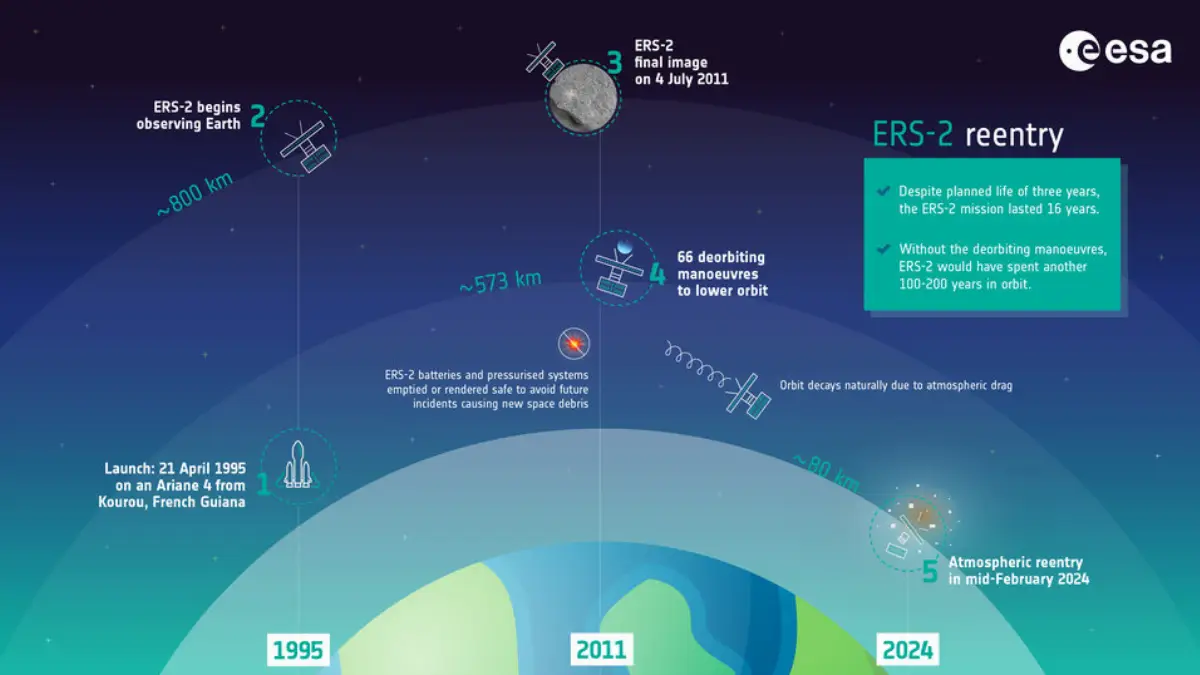
ERS-2 reenters Earth’s atmosphere over Pacific Ocean
The satellite was launched almost 30 years ago, in 1995

At approximately 18:17 CET (17:17 UTC) on Wednesday 21 February 2024, ESA’s ERS-2 satellite completed its atmospheric reentry over the North Pacific Ocean. No damage to property has been reported.
ESA’s second European Remote Sensing satellite, ERS-2, was launched almost 30 years ago, on 21 April 1995. Together with the almost-identical ERS-1, it provided invaluable long-term data on Earth’s land surfaces, ocean temperatures, ozone layer and polar ice extent that revolutionised our understanding of the Earth system. It was also called upon to monitor and assist the response to natural disasters.
Having far exceeded its planned lifetime of three years, ESA took the decision to deorbit ERS-2 in 2011 in light of growing concern over the long-term hazard that orbital debris poses to current and future space activities.
The satellite’s altitude had been declining steadily ever since. On 21 February 2024, it reached the critical altitude of around 80 km at which the atmospheric drag was so strong that it began to break into pieces.
An international campaign involving the Inter-Agency Space Debris Coordination Committee and ESA’s Space Debris Office monitored the reentry.
ERS-2’s reentry was "natural". All of its remaining fuel was depleted during deorbiting to reduce the risk of an internal malfunction causing the satellite to break up into pieces while still at an altitude used by active satellites. As a result, it was not possible to control ERS-2 at any point during its reentry and the only force driving its descent was unpredictable atmospheric drag.
This was the best option for disposing of the satellite given the way it was designed in the 1980s. However, the time and location of a natural reentry are difficult to predict prior to the satellite’s final few hours in space.
ESA’s missions in Earth orbit are now designed to conduct ‘controlled’ reentries. During a controlled reentry, spacecraft operators can ensure that the satellite comes down over sparsely populated regions on Earth such as the South Pacific Ocean.
Meanwhile, ESA continues to make efforts to dispose of its older satellites (such as ERS-2, Aeolus, Cluster and Integral) in more sustainable ways than were originally planned.
ERS-2, and its predecessor ERS-1, were the most sophisticated satellites ever developed and launched by Europe. The satellite carried a suite of scientific instruments and technologies into orbit that collected valuable data for more than one and a half decades, including Europe's first instrument to study atmospheric ozone. The ERS heritage datasets are today curated and made accessible through ESA’s Heritage Space Programme.
The ERS satellites also set the stage for many successor missions dedicated to studying our changing world, such as Envisat, the MetOp weather satellites, ESA’s Earth Explorer scientific research missions and the Copernicus Sentinels, as well as many other national satellite missions.
AVIONEWS - World Aeronautical Press Agency